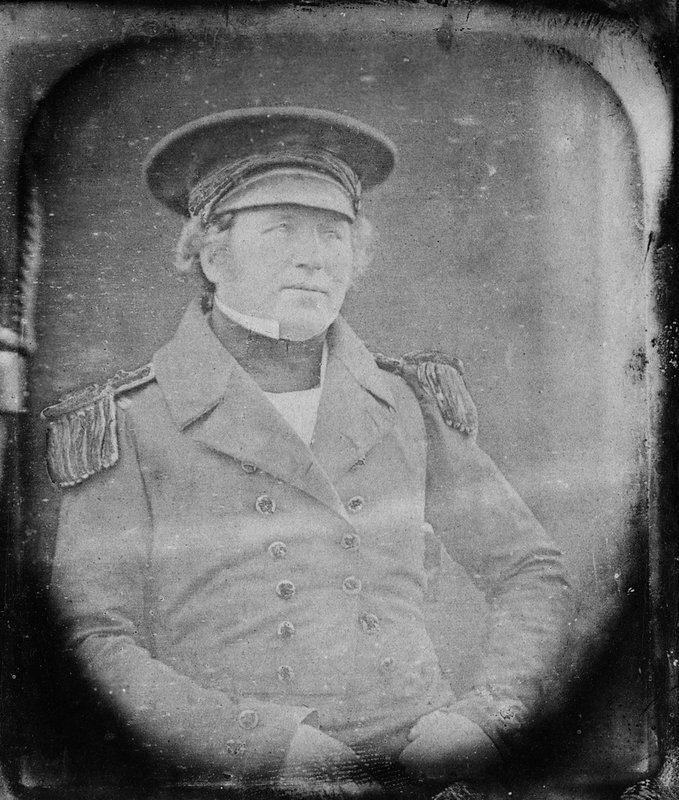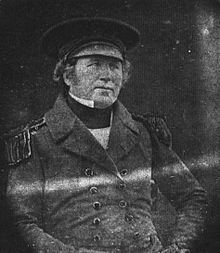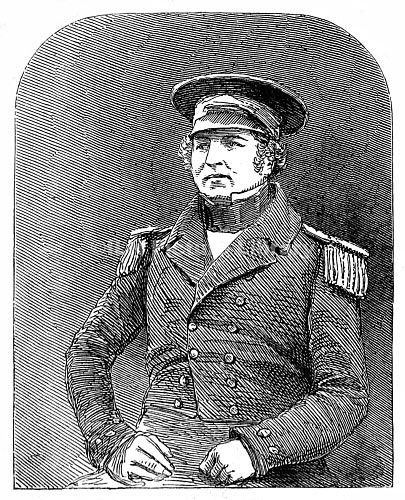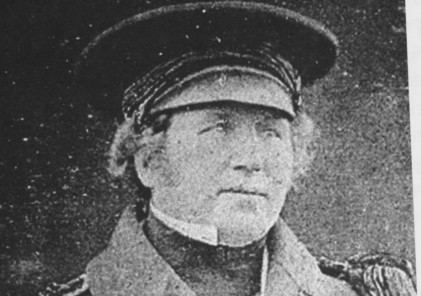Allegiance United Kingdom | Name Francis Crozier Years of service 1810–48 | |
 | ||
Died 1848, King William Island, Canada | ||
Voices francis crozier
Francis Rawdon Moira Crozier (17(?) September 1796 – disappeared, 26 April 1848) was an Anglo-Irish naval officer who participated in six exploratory expeditions to the Arctic and Antarctic. Не was born in Ireland at Banbridge, County Down and was named after his father's friend Francis Rawdon, the 2nd Earl of Moira.
Contents
- Voices francis crozier
- Francis CrozierJared Harris Sophia CracroftSian Brooke The Terror
- Early life
- Naval service
- Antarctic exploration
- Northwest Passage expedition
- Tributes
- Geographical features
- Discovery of the ships
- In the media
- References

Francis Crozier(Jared Harris) & Sophia Cracroft(Sian Brooke) - The Terror
Early life

Francis Crozier was born at Avonmore House, Banbridge, County Down, Northern Ireland. He was the eleventh of thirteen children, and the fifth son of attorney-at-law George Crozier, Esq. Crozier attended school locally in Banbridge, with his brothers William and Thomas, and lived with his family in Avonmore House which his father had built in 1792, in the centre of Banbridge.
Naval service

At the age of 13, Crozier volunteered for the Royal Navy and joined HMS Hamadryad in June 1810. In 1812 he served on HMS Briton and in 1814 visited Pitcairn Island, where he met the last surviving mutineers from HMS Bounty. In 1817 he received his certificate as mate and in 1818 he served on the sloop Dotterel during a trip to the Cape of Good Hope. In 1821 Crozier volunteered to join Captain William Edward Parry's second expedition (1821–23) to find the Northwest Passage in the vessels HMS Fury and her sister ship HMS Hecla. He returned to the Arctic with Parry in 1824, which resulted in the loss of Fury off Somerset Island. Crozier was promoted to the rank of lieutenant in 1826 and in 1827 joined Parry's failed attempt to reach the North Pole. During his voyages Crozier became a close friend and confidante of the explorer James Clark Ross. He was elected a Fellow of the Royal Astronomical Society in 1827 after conducting valuable astronomical and magnetic studies on his three expeditions with Parry. He was appointed to the frigate HMS Stag in 1831 and served off the coast of Portugal during that country's civil war. Crozier joined James Clark Ross as second-in-command of Cove in 1835 to help search for 12 British whaling ships lost in the Arctic. Crozier was appointed to the rank of commander in 1837.
Antarctic exploration

In 1839, Crozier again joined James Clark Ross, as second-in-command of a four-year voyage to explore the Antarctic continent in the ships HMS Erebus and HMS Terror. Crozier commanded Terror, and in 1841 was appointed to the rank of captain. Erebus and Terror returned in 1843, having made the most significant penetration of the Antarctic pack ice and discovered large parts of the continent – including the Ross Sea and Ross Island, Mount Erebus and the Ross Ice Shelf.
Crozier was elected a Fellow of the Royal Society in 1843 in recognition of his outstanding work on magnetism.
Northwest Passage expedition
In 1845, Crozier joined Sir John Franklin on the Northwest Passage expedition, as captain of HMS Terror. After Franklin's death in June 1847, he took command of the expedition, and his fate and those of the other expedition members remained a mystery until 1859, when a note from him and James Fitzjames, captain of Erebus, the other ship on the expedition, was discovered on King William Island during an expedition led by Captain F. L. McClintock. Dated 25 April 1848, the note said the ships, stuck in ice, had been abandoned. Nine officers, including John Franklin, and 15 crewmen had died, and the survivors were setting out on 26 April for Back's Fish River on the Canadian mainland. There were later, unverified Inuit reports that between 1852 and 1858 Crozier and one other expedition member were seen in the Baker Lake area, about 400 km (250 mi) to the south, where in 1948 Farley Mowat found "a very ancient cairn, not of normal Eskimo construction" inside of which were shreds of a hardwood box with dovetail joints. McClintock and later searchers found relics, graves, and human remains of the Franklin crew on Beechey Island, King William Island, and the northern coast of the Canadian mainland, but no survivors.
Tributes
In January 2008, Crozier's home town of Banbridge, Northern Ireland hosted a memorial event, which included a service of remembrance and thanksgiving at the Church of the Holy Trinity, which was attended by more than 100 descendants of Crozier and other officers of the Franklin expedition and those who searched for it, along with the chairman of the Banbridge Council, and several Arctic historians, including Michael Smith and Russell Potter.
A memorial to the memory of Sir John Franklin and his men, including Crozier, was erected by order of Parliament in 1858 in the Painted Hall of the Greenwich Hospital, London. It was moved to the Chapel of the Royal Naval College, Greenwich, in 1937, and was re-erected in the entrance of the former college in late 2009. At the service of thanksgiving on 29 October 2009, polar travellers and descendants of Sir John Franklin, Captain Crozier and their men celebrated their contributions.
Geographical features
Geographical features named after Crozier include:
Discovery of the ships
In 2014, the "Victoria Strait Expedition" found two items on Hat Island, in the Queen Maud Gulf, near Nunavut's King William Island: part of a boat-launching davit bearing the stamps of two Royal Navy broad arrows; and a wooden object, possibly a plug for a deck hawse, the iron pipe through which the ship's chain cable would descend into the chain locker below. It then located one of Franklin's two ships, preserved in good condition. The wreck lies at the bottom of the eastern portion of Queen Maud Gulf, west of O'Reilly Island. The wreck has been confirmed to be that of HMS Erebus, the expedition's flagship. In 2016, a ship matching Terror's description was located in Terror Bay, off the southern coast of King William Island.
In the media
In the comic book Alpha Flight, Crozier became the villain Pestilence. Crozier is the main protagonist of Dan Simmons' 2007 novel The Terror. He is one of the narrators of Dominique Fortier's 2008 novel "Du bon usage des étoiles", a finalist for the 2009 Governor General's Awards.
